“A lot of people are afraid of heights. Not me. I’m afraid of widths.”
– Stephen Wright, comedian
Buenos Aires – While it may not be the most commonly asked question in Buenos Aires, which is probably “Where do I get the best steak?” (an unanswerable query if ever there was one), it certainly comes up a lot – “Is Avenida 9 de Julio really the widest street in the world?” (Just for numbers sake, though there’s disagreement, and it depends where along the avenue, but roughly, it’s 110 meters wide and has 18 lanes of traffic.) But there’s not a simple answer. If you include highways, then no, there are wider highways, both in terms of number of lanes (Highway 401 outside of Toronto has 21 lanes) and physical width. But let’s limit it to streets and avenues. There’s some contention that the avenue that connects the Forbidden City to Tian’anmen Square in Beijing has more lanes, but I haven’t seen a definitive answer. There’s an avenue in Brasilia, Brazil, which is physically wider at 250 meters, and another in Canberra, Australia at the same width, but, both have fewer traffic lanes – the one in Brazil, amazingly at that width, apparently only has four lanes of traffic!
Still, like many things in this country where the people are as proud of their patrimony and claims to fame as they are critical of their own national problems, let’s face it, it’s a really wide street. It’s home to a wide range of architecture, from the Beaux Arts style of the French embassy at its northern end on through modern office buildings, block academic styles, and into low height, simple commercial buildings, almost strip-mall like, at its southern terminus, where it becomes a highway in its own right. I spent a day walking the 26 blocks that constitute the avenue section, with an eye primarily on the wide range of sculptures and monuments that freckle its traffic islands. It’s a somewhat zigzagging walk to make, as at moments the traffic islands are in the center of the whole thing, and at other times the central median narrows to nothing and the side islands widen out into small plazas. A good percentage of the statuary is not identified by inscription or plaque, but I’ve done my best to ferret out information where I could. Just because of the quantity of information, I’ll break this post into parts over the next week or so.
The avenue was planned out for construction in 1911, but the work on it did not begin until 1937. Within four months, the first five blocks, from Mitre to Tucumán were open, but then it took more than forty years to complete the avenue – perhaps a claim to have been the slowest avenue to be built would be in order? It’s name, by the way, commemorates July 9, 1816, Argentina’s “birth-date” – though when planned in 1911, it was to be called Ayohuma after a major battle in the struggle for the country’s independence.
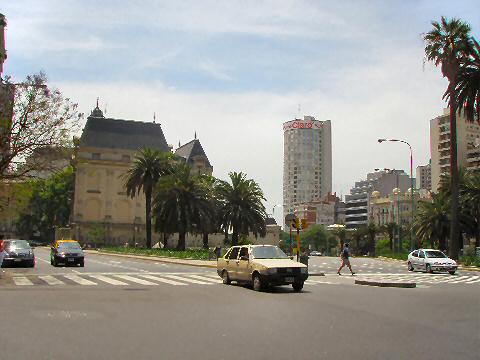
We begin at the northern end, the exit from the highway that runs along the river, as well as where the service roads come up from Retiro station. The French embassy sits on a point of land at the corner of Arroyo, and a row of palm trees lines the center island.
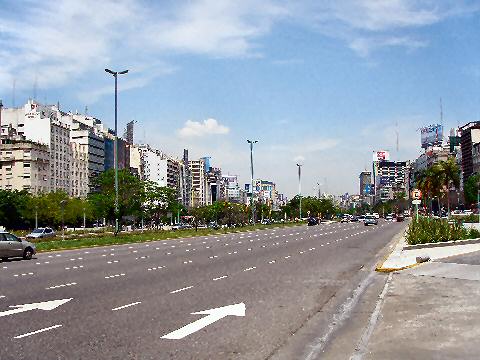
Turning around, we look south and on up the avenue – this end is primarily commercial office buildings, with scatterings of interesting architecture.
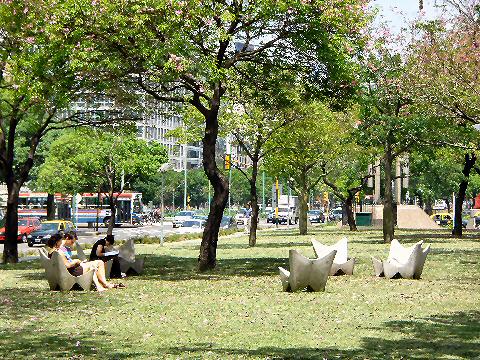
I don’t know that the median strip of this avenue is where I’d choose to sit and read, despite its greenery, but it seems to be the spot of choice for a good number of folk, and the entire length of the avenue is lined with either these strange concrete chairs or more typical park benches.
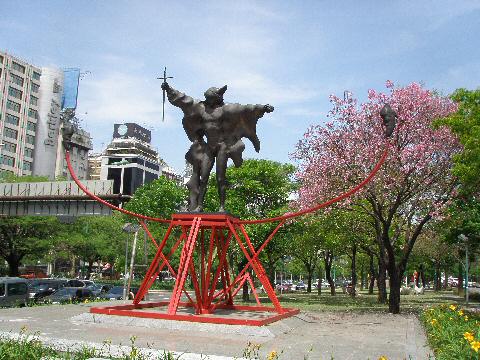
The first piece of statuary is this wide-armed commemoration of Christopher Columbus’ discovery of America on the 500th anniversary, October 12, 1992, and is titled
Cristobal Colón “En Las Americas”. The bronze and steel sculpture is by Ugo Attardi, a Ligurian artist, who also sculpted the famous heroic sculpture of Ulysses in NYC’s Battery Park; it was donated to the city of Buenos Aires by the Italian government. Interestingly, I’ve seen photos, and originally the entire sculpture was charcoal grey – the base was repainted bright red in, I believe, 2004, at which time a new identification plaque was also placed at its base.
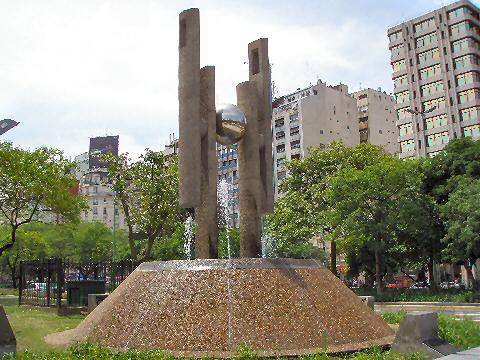
Entitled
Monumento Democracia, this is a sculpture by Czech artist Gyula Kosice, dated from May 27, 1999. It is constructed of concrete and steel, and, beyond that, and that it’s abstract, I can’t really tell you much about it.
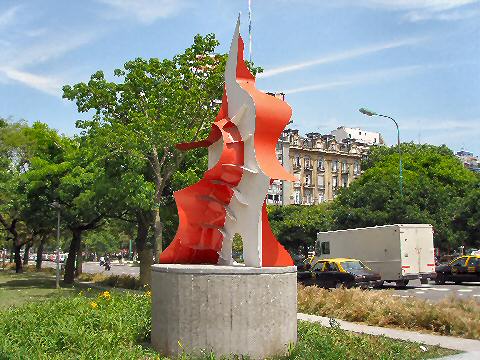
Celebrating a century of Argentine-Japanese friendship, a centennial which happened on February 3, 1998 (the anniversary of a Japanese Argentine treaty), this sculpture was placed a couple of years later on June 3, 2000. It is entitled
Grulla, or “crane” (both kinds, but presumably the bird in this case) and was a gift of the Centro Nikkei Argentino to the city. The work is by Julio Eduardo Goya, a second generation Japanese Argentine, who returned to Japan in 1985.
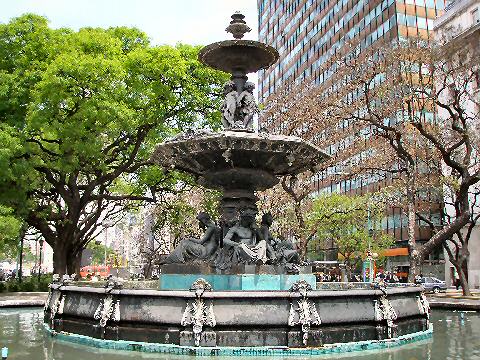
A fountain at the corner of Av. Córdoba, made of masonry and steel, by the Du Vall d’Osne Foundry in France. The only information I could find about the fountain is that it’s been moved twice. Who knew they moved fountains? It was originally placed in the center of Plaza de Mayo, at that time, in 1868, called Plaza de Victoria. Nearly a century later, on May 3, 1960 it was moved to the Parque Los Andes, the long, narrow park to the side of the
Chacarita Cemetery. In May 1969 it was moved to its present location. It seems to have become the bathing spot for the local homeless, particularly on hot days.
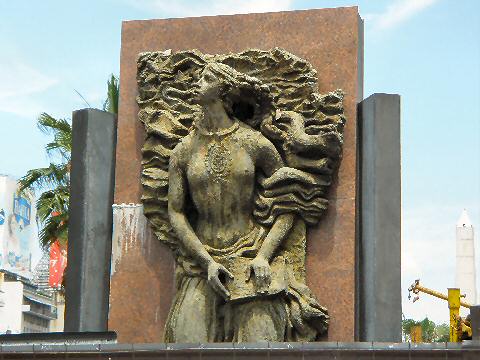
A block further on is this relief sculpture that is currently behind some construction walls, so I was just able to get a photo of the top of it and can’t tell you more about it at the moment. I had a Star Wars/Hans Solo flashback for a moment….
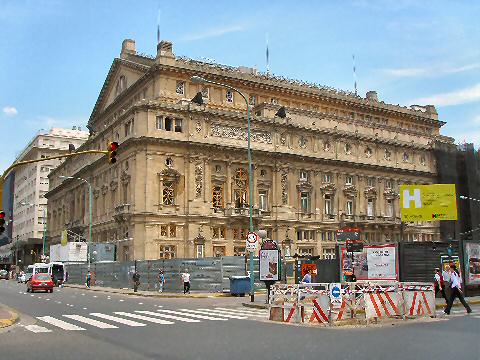 Teatro Colón
Teatro Colón (Columbus Theater) itself, under renovation for the last year or two and expected, potentially, to be reopened in 2010. I’ll save the teatro for another post one day – I think I still have photos from my first visit there a few years ago, or maybe I’ll wait until the re-opening.
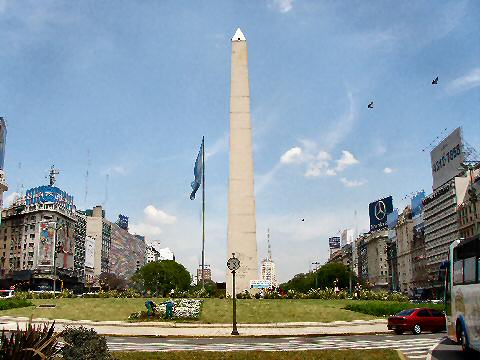
The
Obelisco, or Obelisk, a copy in form of the Washington Monument, though less than half the height at 220 feet tall. It took a mere month to build, back in May 1936, commemorating 400 years since the founding of the city. It was designed by local architect Alberto Prebisch.
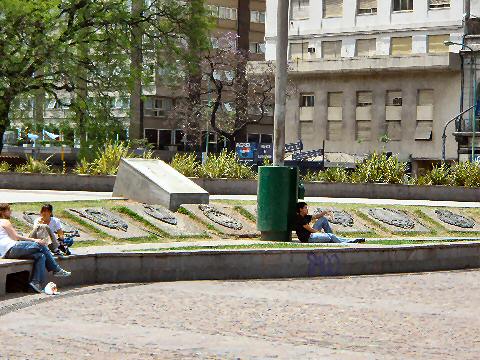
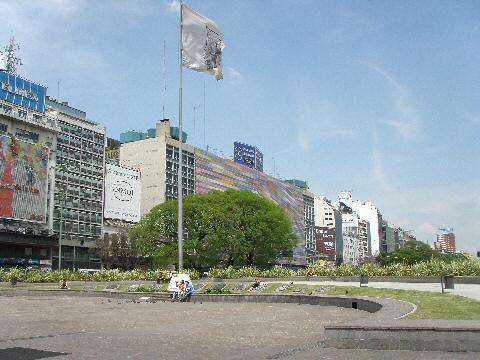
To the north and south of the
Obelisco are two semi-circular plazas, each lined with plaques that are the provincial seals of the provinces of the nation. The plaza to the north is marked by the national flag of Argentina, and that to the south with the coat-of-arms of the City of Buenos Aires. The plazas are popular gathering spots for sports fans after a big win, for demonstrators against one or another thing, and a teen hangout to catch some rays and meet up with friends.
I’m going to leave off here, at the “central marker” point of the avenue, and pick this up in another post….

















[…] Aires – When we left off on walking on the last post, we’d made it to the plaza around the Obelisco as we meandered Av. 9 de Julio. There’s […]